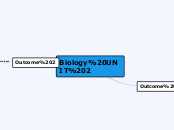Biology UNIT 2
Outcome 2
Genotypes and Phenotypes
Qualitative treatment of polygenic inheritance as contributing to continuous variation in a population, illustrated by the determination of human skin colour through the genes involved in melanin production or by variation in height
The relative influence of genetic material, environmental factors and interactions of DNA with other molecules (epigenetic factors) on phenotypes
The distinction between a dominate and recessive phenotype
The use of symbols in writing of the genotypes for the alleles present at a particular gene locus
Outcome 1
Cell cycle
The rapid procession of prokaryotic cells through their cell cycle by binary fission
Derivation of all cells from pre-existing cells through completion of the cell cycle
Sexual Reproduction
The biological advantages of sexual reproduction, specifically the genetic diversity in offspring
The key events in meiosis that results in production of gametes from somatic cells including the significance of crossing over chromatids between homologous chromosomes in Prophase 1 and the non-dividing of the centromere in Metaphase 1
How an offspring from two parents has a unique genetic identity
Asexual Reproduction
The types of asexual reproduction including fission, budding, vegetative propagation and spore formation
Emerging issue associated with cloning, including applications in agriculture and horticulture
The biological advantages and disadvantages of asexual reproduction

